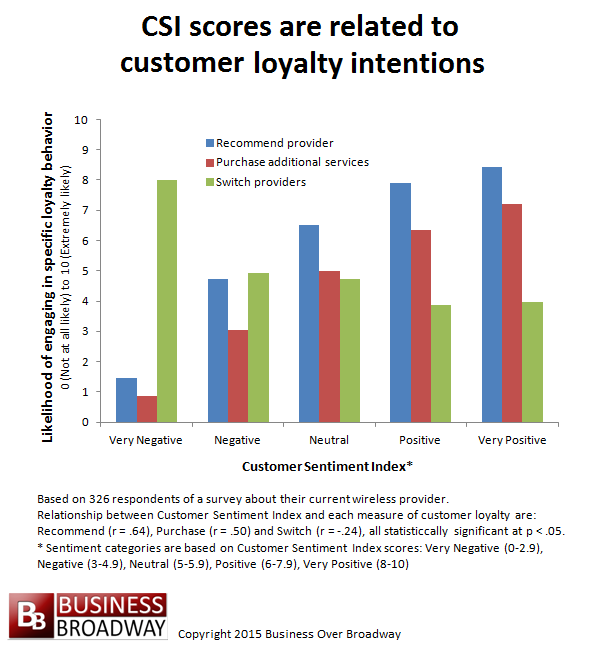Last month, I illustrated a new method of measuring customers’ attitudes about a company’s product or brand. This method is unique because it combines both a structured and unstructured measurement approach.
Companies can use an open-ended survey question that asks customers to provide a single word that best describes the company/brand. From this one word, companies can apply a numerical value to each word that represents a sentiment value for that word. I found that customer sentiment (as measured by this new method) is highly correlated with traditional ratings of customer satisfaction (r = .71).
In today’s post, I will explore the extent to which this new method of measurement is predictive of different types of customer loyalty, including likelihood to recommend, likelihood to purchase more and likelihood to churn.
Sample and Metrics
The sample of respondents were solicited from Amazon Turk to complete a customer survey about their current wireless service provider. I received 460 completed survey response. The customer survey contained several questions that included the new method (i.e., “What one word best describes your wireless service provider?”) as well as questions from a standard customer relationship survey (see Customer Relationship Diagnostic).
The survey included several customer loyalty questions that will be highlighted in the analysis:
- How likely are you to recommend <company name> to your friends/colleagues?
- How likely are you to purchase additional services from <company name in the next 12 months?
- How likely are you to switch to a different wireless service provider within the next 12 months?
For each of the loyalty questions above, respondents were asked to indicate how likely they are to engage in the specific behavior in question using the following scale: 0 (Not at all likely) to 10 (Extremely likely).
Customer sentiment was calculated by applying a sentiment score to each word. The sentiment scores for particular words were derived using existing data from several large annotated corpora. This mapping of sentiment values to words constitutes the Customer Sentiment Index. The CSI can range from 0 (negative sentiment) to 10 (positive sentiment).
Results
The descriptive statistics of and the correlations among the four measured are presented in Table 1. As a whole, customers are more likely to recommend their wireless service providers (7.24) than they are to purchase additional services from them (5.78). Also, as a whole, customers are not likely to switch providers (4.29).

Looking at the relationship of CSI scores with each measure of customer loyalty, we find that CSI was more strongly related to recommending intentions compared (r = .64) to purchasing intentions (r = .50) and switching intentions (r = -.24). It appears that sentiment primarily drives advocacy behaviors (e.g., recommending), and, to a lesser degree, purchasing and retention behaviors.
Mapping the Relationships
Next, I plotted (see Figure 1) the relationships among the study variables to better understand how customer sentiment is related to the different types of customer loyalty. As you can see in Figure 1, customer sentiment is linearly related to both recommending and purchase intentions. However, customer sentiment is not linearly related to switching intentions; that is, increasing levels of positive sentiment have little effect on decreasing switching intentions. So, while increasing levels of sentiment indicate in higher levels of recommendations and purchases from your customers, it would not necessarily mean lower levels of customer churn.

Summary
A single word response in a customer survey can be used to both quantify customer sentiment toward a brand (via Customer Sentiment Index) and provide a useful metric about the health of the customer relationship.
The Customer Sentiment Index (CSI) appears to be a useful predictor of customer loyalty. Customer sentiment is closely associated with recommendation and purchasing intentions and weakly associated with switching intentions. Lower levels of customer sentiment are associated with poorer levels of customer loyalty.
Recommending and purchasing behaviors are strongly driven by the overall quality of the customer relationship (as measured by the CSI). On the other hand, switching behaviors appear to be less relationship-driven; negative types of loyalty behaviors could driven more by specific events or transactions (e.g., promotional offer to switch, infuriating customer experience) than the quality of the overall relationship.




Bob: With the ‘single word’ survey method you describe I’m wondering how ambiguity and lack of redundancy might skew the results. In our general discourse, additional words provide confirmation of meaning. Putting all the ‘sematic eggs in a one-word basket’ opens up the possibility for confused interpretations. Maybe you’ve addressed this matter elsewhere –
As far as positive sentiment correlating with recommendations and negative sentiment not highly correlated with switching – I’m not surprised. I think your finding speaks to the fact that there’s relatively low effort in giving a recommendation, but high effort in switching providers. It takes an extraordinarily bad experience to rip out the communication channels and replace them with something else that is also not risk-free. I expect that vendors are (or should be) well aware of this human behavioral pattern.
The current survey methods do leave brands blindfolded in the middle of a highway with a pencil for a walking stick. Last week our company processed 36,000 hours of phone conversations in less than an hour. In matter of seconds we were able to find all the conversations which showed high negative sentiment and emotion based on semantic analysis and vocal markers.
What lowers NPS? An agent who couldn’t care less, but has a great AHT. An offer that was sold, even though it didn’t really match customer’s needs. An issue that was left unresolved for three days straight because it was mis-tagged as a First Call Resolution. It took an analysis of 5 million words to find these loyalty – damaging occurrences. Not sure how constructive can a one word opinion be. Unless it’s just a quick, occasional, micro health-check. Like measuring your temperature to check if you have cancer.